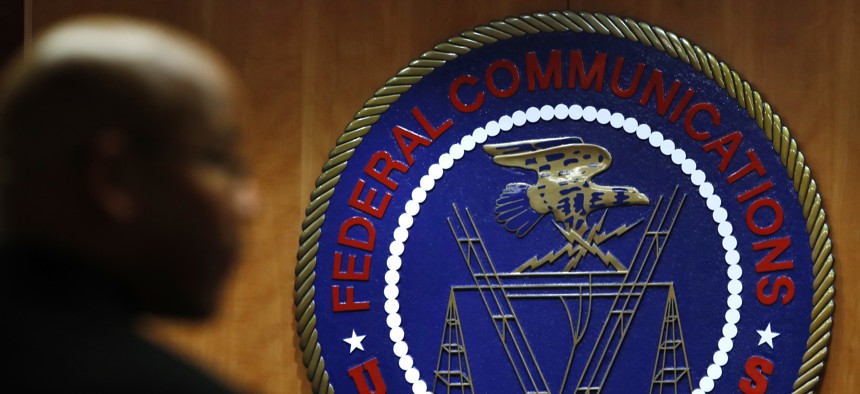The FCC Wants Your Feedback to Improve Broadband Access

This Dec. 14, 2017, file photo, shows the seal of the Federal Communications Commission (FCC) before a meeting in Washington. AP Photo/Jacquelyn Martin
In an effort to create more accurate maps detailing broadband connections and service, the Federal Communications Commission is collecting first-hand accounts from users.
The Federal Communications Commission wants to hear first-hand from consumers about the availability and quality of broadband in communities across the United States as part of an effort to improve internet access.
The commission launched a new feedback form this week that will allow internet users to share their experiences regarding broadband access, speed, and carrier availability as the FCC works to improve the accuracy of its broadband maps.
“Far too many Americans are left behind in access to jobs, education, and healthcare if they do not have access to broadband,” said Acting FCC Chairwoman Jessica Rosenworcel. “Collecting data from consumers who are directly affected by the lack of access to broadband will help inform the FCC’s mapping efforts and future decisions about where service is needed.”
The FCC’s broadband maps are known to overstate the availability of broadband across the United States because they rely on data collected from internet service providers. If a provider offers service to at least one household in a census block, the FCC counts that entire census block as having broadband coverage.
It’s an issue states have tried to remedy in the past by collecting their own data to understand service gaps. Delaware, for example, surveyed residents to assess their internet connection speeds.
The coronavirus pandemic has elevated the importance of improving both broadband infrastructure and the collection of data about broadband availability in the United States.
The latest data collection project is just one of several broadband-related initiatives launched by the FCC in recent weeks. Last month, the FCC established a Broadband Data Task Force that will lead cross-agency efforts to develop more precise maps detailing broadband availability.
Rosenworcel has pushed for better mapping data in the past, arguing that the FCC needs a better understanding of where broadband is and isn’t available before spending money to expand service. She’s said that the FCC needs to build a comprehensive, user-friendly dataset on broadband availability that can supplement the data gathered from internet service providers and also consider input from state and local governments, and consumers.
“We must also develop, test, and launch IT systems to collect and verify these data,” Rosenworcel wrote in a recent blog post laying out the FCC’s broadband improvement strategy. “Then we will create—for the first time—a publicly accessible, data-based nationwide map of locations where broadband is truly available throughout the United States.”
In addition to improving broadband mapping data, there are other ongoing federal efforts to help subsidize expansion and access.
The FCC recently approved rules to implement the Emergency Broadband Benefit Program, a $3.2 billion initiative that provides qualifying households with discounts of up to $50 a month for broadband service.
And the $1.9 trillion coronavirus relief bill signed into law this month allocates $7 billion to the FCC to help schools and libraries support remote learning for students. The bill also allows state and local governments to spend their direct aid on broadband infrastructure improvements.
Andrea Noble is a staff correspondent with Route Fifty.
NEXT STORY: National Homelessness Estimate Grows for Fourth Consecutive Year





